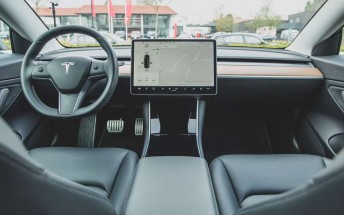Flashback: MediaTek's Helio X20 chip with 10-core CPU was ahead of their time

Modern smartphone chipsets are awesome – their CPUs reach incredible clock speeds of up to 3.46GHz on the iPhone 14 Pro series (Apple A16). The Android rivals aren’t far behind at 3.36GHz with the Snapdragon 8+ Gen 2.
But while raising the clock speed is a simple way to increase performance, it comes with major issues, mainly related to much higher power draw and overheating. Can you go faster while keeping the clock speed low? Sure you can, just throw more cores at the problem.
That must have been the line of thought back in 2015 when MediaTek announced the Helio X20, the world’s first deca-core mobile CPU. It had a pair of big Cortex-A72 (ARM’s big core of the day) running at up to 2.5GHz, then an island of four Cortex-A53 cores at 2.0GHz and another island of four A53s at 1.4GHz.

To reiterate our initial point, CPU performance and power draw don’t scale linearly. Small cores sip power, but push them too hard and you’re just wasting electricity. Big cores are fast, but they can’t go slow – you’re wasting electricity again.
Here is MediaTek’s justification for why the two-cluster design is flawed. There is a gap between the performance of little and big cores and the two clusters have to be kept relatively close together. Here is an illustration:

With three clusters, however, you can straighten out the speed/power draw curve while also stretching it out at the low end and at the high end.

As you might have noticed, it’s really the middle cluster that is the innovation here. It allows the small cores to be optimized for low power draw and the big cores for speed, the resulting gap between them will be plugged by the mid cores.
According to MediaTek’s estimates, the Helio X20 was 30% more power efficient than a similar chipset with only two clusters.
The X20 had other clever features too, like the “world’s first integrated Cortex-M4”. You don’t hear much about the M-series, these tiny, low-power chips are used in anything from washing machines to smart bands.
And MP3 players. The X20 could offload tasks to the Cortex-M4, things like MP3 playback or running the audio compression for voice calls. Even a Cortex-A53 is way too powerful for such uses. Again, using a core that’s too big for the task at hand is inefficient.

The Helio X20 was fabbed on a 20nm process at TSMC’s foundries. Besides the 10-core CPU, it also had a Mali-T880 MP4 GPU and a built-in Cat. 4 LTE modem. This chip was announced in mid-2015 but we had to wait until MWC 2016 to get our hands on the first smartphone with a 10-core CPU.
Who can forget the Zopo Speed 8? Wait, what, Zopo? Zopo wasn’t nearly as famous as the similarly named Oppo and didn’t last long on the market, but this phone does deserve to be remembered.
The Speed 8 paired the Helio X20 chipset with 4GB of RAM and 32GB storage, it ran Android 6.0 Marshmallow and all this was powered by a 3,600mAh battery with USB-C charging. On the front was a 5.5” 1080p display, on the back a 21MP camera.
Looking back at it now, it was quite a beautiful design. The phone went on pre-order in March 2016 at $280, so it was great value for money too.
So, how fast was it? Alas, the reality was disappointing. The Cortex-A72 is a nice core, but it was never the fastest. Not at these clock speeds – that 2.5GHz target for the A72 cores that you saw above proved to be too ambitious and MediaTek had to down clock it to 2.3GHz.
The Helio X20 was soundly beaten by Apple’s big cores inside the iPhone 6s with its Apple A9 chip (two Twister cores at a modest 1.85GHz). The HTC 10 and LG G5 too, both with a Snapdragon 820. This one had two Kryo cores at 2.15GHz and two more at 1.59GHz.
GeekBench 3 (single-core)
Higher is better
-
Apple iPhone 6s Plus
2527 -
HTC 10
2368 -
LG G5
2328 -
Xiaomi Mi 5
2305 -
Samsung Galaxy S7 edge
2151 -
Meizu Pro 6
1905 -
Huawei P9
1819 -
Zopo Speed 8
1625 -
Meizu Pro 5
1545 -
Samsung Galaxy S6 edge+
1490 -
Huawei Nexus 6P
1363
But this is just the single-core test, it’s no surprise that a few big cores can win over many smaller cores. The Helio X20 will shine in the multi-core test, right? Well, have a look for yourself.
This chart was topped by the Samsung Galaxy S7 edge with its Exynos 8890. This had four big Samsung-designed Mongoose cores at 2.3GHz and four ARM-designed Cortex-A53 at 1.6GHz.
GeekBench 3 (multi-core)
Higher is better
-
Samsung Galaxy S7 edge
6600 -
Huawei P9
6558 -
Meizu Pro 6
6427 -
Meizu Pro 5
5578 -
LG G5
5362 -
Xiaomi Mi 5
5358 -
HTC 10
5257 -
Samsung Galaxy S6 edge+
5158 -
Meizu MX5
5110 -
Huawei Nexus 6P
4539 -
Apple iPhone 6s Plus
4413 -
Zopo Speed 8
4128 -
Meizu MX4 Pro
3386
Just a hair behind is the Huawei P9 with a Kirin 955 – four Cortex-A72 at 2.5GHz and four A53 cores at 1.8GHz. See? The A72 is a pretty good core. But how come the Kirin is faster?
For starters, the Kirin 955 has four A72 cores, not just two like the Helio X20. And as we mentioned already, the cores in the Helio could only go as high as 2.3GHz, which hurt its single-core scores.
Have another look at those benchmarks above – the Meizu Pro 6 (in blue) features the improved Helio X25 chipset, a refined version of the X20. If anything, it was what the X20 was supposed to be because it actually ran its two Cortex-A72 cores at 2.5GHz (plus four A53 at 2.0GHz and four more at a higher 1.55GHz).
While the GPU was pretty weak compared to other chipsets (not enough cores), the CPU got closer to the results that we expected out of a 10-core design.

While the Helio X25 was meant to be exclusive to the Meizu Pro 6 (it was co-developed by MediaTek and Meizu, apparently), a few other brands got a taste as well. The Xiaomi Redmi Pro used the same chip, as did the LeEco Le 2 Pro.


Xiaomi Redmi Pro • LeEco Le 2 Pro
Next came yet another refinement of the same hardware, the Helio X27. It boosted the two Cortex-A72 cores even higher to 2.6GHz. Also, the Mali-T880 GPU was overclocked, but with only four cores it was still slow compare to high-end chips.
The X27 was used in another LeEco phone, the Le Pro 3 AI Edition (the folks at LeEco were true poets) and a year later it was featured in the Land Rover Explore too.


LeEco Le Pro 3 AI Edition • Land Rover Explore
So far we had only seen refinements on the original 10-core design, MediaTek would unveil a true sequel in 2016 – the Helio X30. It was off to a great start, upgrading to a 10nm TSMC node, while the X20 series used the aging 20nm node.
And it changed up the three CPU clusters. The big cores now numbered four and were switched to the newer Cortex-A73 running at a respectable 2.8GHz. The middle cluster stuck with four Cortex-A53 cores (now at 2.2GHz), while the small cluster made the interesting choice of using a pair of Cortex-A35 (yes, A35) cores at 2.0GHz.
The Helio X30 was used only on two phones – the Meizu Pro 7 (only in the “high” edition, the standard version used a Helio P25) and the Meizu Pro 7 Plus. Maybe there just wasn’t much demand for 10-core CPUs, but either way this time Meizu got its exclusivity.
 Remember the Meizu Pro 7 Plus? It had a display on its back
Remember the Meizu Pro 7 Plus? It had a display on its back
Unfortunately, when we reviewed the Meizu Pro 7 Plus, we couldn’t run the CPU-only Geekbench test. But here is how the phone did on AnTuTu 6 and Basemark OS 2. As you can see, the Snapdragons were still in the lead. Even the Galaxy S7 edge with its aging Exynos 8890 was still putting up a fight.
AnTuTu 6
Higher is better
-
OnePlus 5
180331 -
Xiaomi Mi 6
177326 -
Nokia 8
175872 -
Samsung Galaxy S8
174435 -
OnePlus 3T
165097 -
Sony Xperia XZ Premium
144223 -
LG G6
143639 -
Sony Xperia XZs
133574 -
Samsung Galaxy S7 edge (E8890)
129229 -
Huawei Mate 9 Pro
128719 -
Meizu Pro 7 Plus
128498 -
Huawei P10 Plus
126252 -
Meizu Pro 6 Plus
113397 -
Meizu Pro 6
99195 -
Huawei P9 Plus
97392 -
Meizu Pro 5
67531
Basemark OS 2.0
Higher is better
-
OnePlus 5
3601 -
Xiaomi Mi 6
3547 -
Nokia 8
3503 -
Samsung Galaxy S8
3376 -
Sony Xperia XZ Premium
3174 -
Huawei P10 Plus
2940 -
OnePlus 3T
2678 -
Huawei Mate 9 Pro
2496 -
Sony Xperia XZs
2386 -
Meizu Pro 7 Plus
2380 -
LG G6
2126 -
Huawei P9 Plus
2099 -
Samsung Galaxy S7 edge (E8890)
2050 -
Meizu Pro 6
1919 -
Meizu Pro 5
1837
After the X30, MediaTek gave up on the idea of 10-core CPUs. But not on the three cluster design, which was adopted by other chipset designers too. These days a Dimensity 9000 series chip features a single fast Cortex-X core, three Cortex-A7xx cores in the middle and four A5x at the bottom.
It’s a sound idea but the execution on the Helio X series was lacking and they fell behind the contemporary Snapdragon, Exynos and Kirin chips. These days Kirin is out of the game, Exynos dropped out of the high-end market (though it may return next year) and MediaTek is actually giving Qualcomm a run for its money.
Related
Reader comments
- thatkpopstan
- 26 Aug 2023
- XsV
yeah maybe mediatek could use the X series chipsets when the G series is finished in the future, imo they would've name: Helio X70x, X80x, X90x and X100
- YUKI93
- 18 Aug 2023
- K1F
Even Intel CPU since 12th gen Raptor Lake goes beyond 8-core configuration. As long as the CPU or the SoC has the right thermal management and power consumption balance, it should be good enough for most people.














 Xiaomi
Xiaomi Samsung
Samsung Samsung
Samsung Sony
Sony Nothing
Nothing


